The NVIDIA GeForce GTX Titan X Review
by Ryan Smith on March 17, 2015 3:00 PM ESTMiddle Earth: Shadow of Mordor
Our next benchmark is Monolith’s popular open-world action game, Middle Earth: Shadow of Mordor. One of our current-gen console multiplatform titles, Shadow of Mordor is plenty punishing on its own, and at Ultra settings it absolutely devours VRAM, showcasing the knock-on effect of current-gen consoles have on VRAM requirements.
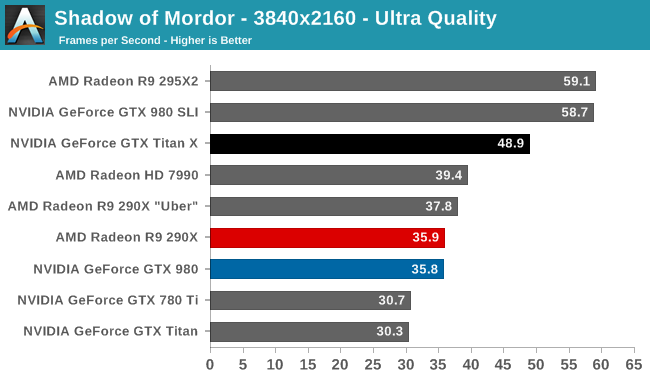
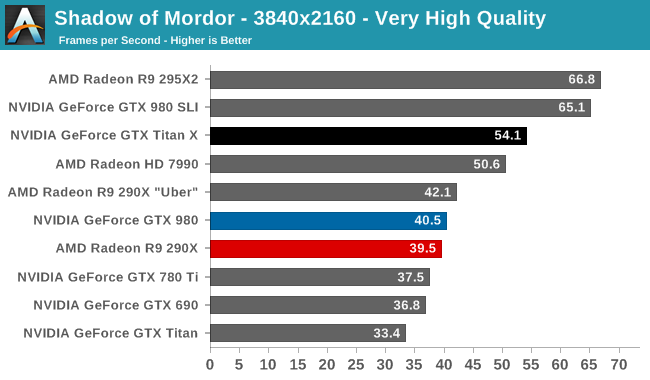
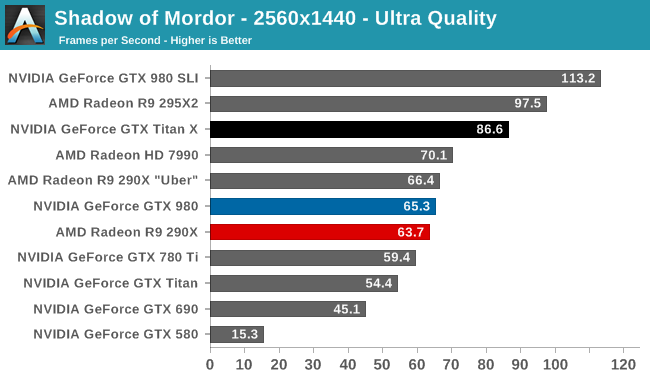
Once again even GTX Titan X won’t be enough for 60fps at 4K, but at 48.9fps it’s closer to 60fps than 30fps, representing a significant improvement in 4K performance in only a generation. Compared to the GTX 980 and NVIDIA’s other cards the GTX Titan X is once more in a comfortable lead, overtaking its smaller sibling by around 33% and the older GK110 cards at 45-60%.
Turning down the game’s quality settings to Very High does improve performance a bit, but at 54.1fps it’s still not quite enough for 60fps. The biggest advantage of Very High quality is alleviating some of the high VRAM requirements, something the GTX Titan cards don’t suffer from in the first place. Otherwise dropping to 1440p will give us a significant bump in performance, pushing framerates over 80fps once again.
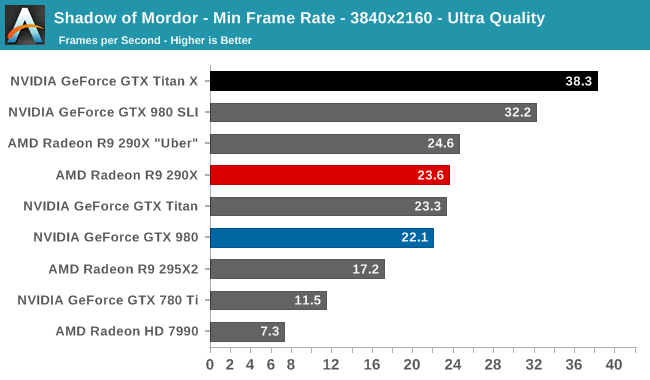

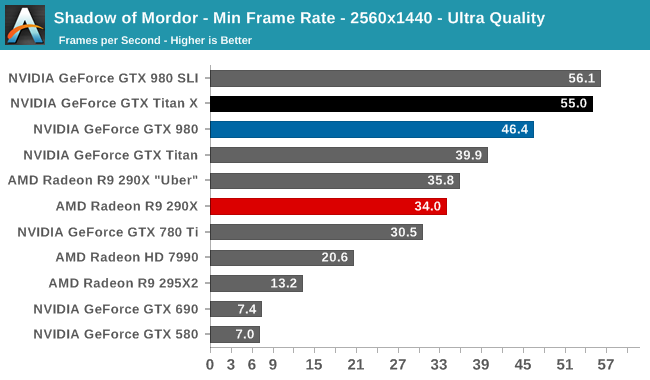
Meanwhile the game’s minimum framerate further elaborates on the performance hit from the game’s high VRAM usage at Ultra quality. 3GB cards collapse here, leaving the 4GB cards and the 6GB original Titan much higher in our charts. Multi-GPU performance also struggles here, even with 4GB cards, reminding us that while multi-GPU setups can be potent, they do introduce performance consistency issues that single-GPU cards can avoid.










276 Comments
View All Comments
Antronman - Thursday, March 19, 2015 - link
The Titan has always been marketed as a hybrid between a gaming and graphics development card.H3ld3r - Thursday, March 19, 2015 - link
Agree 100%H3ld3r - Thursday, March 19, 2015 - link
http://tpucdn.com/reviews/NVIDIA/GeForce_GTX_Titan...Evarin - Thursday, March 19, 2015 - link
For people thinking that VRAM is unneeded, you must not be heavy into modding. Especially with Fallout 4 and GTA 5 on the horizon, massive amounts of room for texture mods will come in handy.Black Obsidian - Thursday, March 19, 2015 - link
6-8GB would seem to meet that requirement nicely.As is often the case with "doubled RAM" models, by the time that 12GB of VRAM is useful, we'll be a couple of generations down the road, and cards with 12GB of VRAM will be much faster, much cheaper, or both.
Maybe at that point a Titan X owner could pick up a cheap used card and run them in SLI, but even then they're laying out more money than a user who buys a $500 card every couple of years and has the VRAM he/she needs when it's actually useful.
H3ld3r - Thursday, March 19, 2015 - link
I agree with you but don't forget how vram is used in sli and cf. Vram of gpu 1 mirrors vram of 0 so if have 2x 4gb you're only taking advantage of 4gb. Anyway i prefer fast ram than hughe amounts of it.Evarin - Thursday, March 19, 2015 - link
We've already had a game which called for 6GB VRAM for an advanced texture pack. Imagine an Elder Scrolls or a Fallout where every single object in the game has a 4k resolution texture. I think it'd be a challenge even for the titan.Antronman - Sunday, March 22, 2015 - link
The way that RAM works is the worse your system is, the more RAM you end up needing.There are plateaus, but as GPUs get faster you need less VRAM to store the same amount of information.
The Titan X is much faster than the Titan BE, and thus needs less VRAM, assuming that the application is the same.
Then we get into Direct X 12 and Vulkan. They're supposed to increase efficiency all-around, reducing the demand for resources like RAM and cores even more.
Death666Angel - Thursday, March 19, 2015 - link
"the card is generally overpowered for the relatively low maximum resolutions of DL-DVI "So I can drive my 1440p 105Hz display with it and get above 105fps? No? So what kind of statement is that then. DL-DVI may be old, but to say that 1440p is a low maximum resolution, especially with 100Hz+ IPS displays which rely on DL-DVI input, is strange to say the least.
H3ld3r - Thursday, March 19, 2015 - link
Based in what i saw in ryan's review 4k games aren't that much memory demanding. If so how can anyone explain R9 performance?